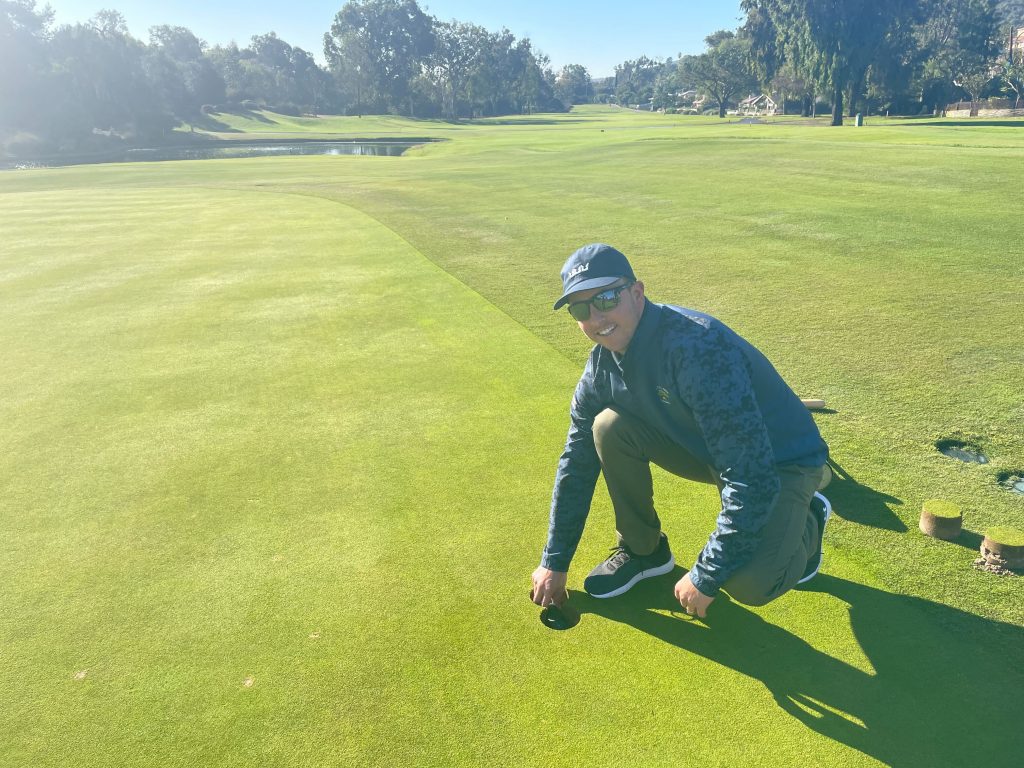Soil Temperature and Moisture Data: Validating Your Instincts with the Spiio Sensor
Matt Morton, superintendent at El Niguel Country Club, shares the value of data in validating and communicating turfgrass decisions. Spiio’s sensor measures soil temperature, moisture, light, and salinity, offering that data in one timely and user-friendly app.

Last year, Matt Morton moved to El Niguel, a private country club in south Orange County, CA. He came with plenty of experience, having been the superintendent at the prestigious Riviera Country Club for twenty years. He also came with a degree in Turfgrass Management from the University of Maryland, where he graduated in 2000. However, new territory still constitutes a learning curve. “It’s like starting from scratch,” says Morton. “You’re familiar with turf and how it responds. But on a new property, you’re re-teaching, re-learning, and re-evaluating the practices you’ve used for years.” Now, as the new superintendent at El Niguel, he’s taken this challenge head-on.
The Spiio Sensor’s Value in Measuring Soil Temperature and Other Indicators
One resource that has been helpful in riding this learning curve is the Spiio sensor. Morton installed four Spiios on the El Niguel course in August of 2020. “It’s been an additional tool to help you understand what’s happening below the greens,” Morton says. For instance, being able to consistently measure soil temperature helps drive several essential turfgrass decisions. “Getting a consistent baseline helps you make any agronomic decisions you need to.”
Getting a consistent baseline helps you make any agronomic decisions you need to.”
The soil temperature and other data has been helpful in Morton’s efforts to better know his new course. However, the value extends beyond that. “I haven’t changed a lot of my agronomic program, but the Spiio has validated my decision-making,” he notes. “The way I’ve touched and felt things for years is now being backed up by science and data.” This validation helps Morton and other turfgrass professionals have greater confidence in their decisions. It also aids in communication with other stakeholders. “I can use the sensor data to educate staff and board members,” he says.
I can use the sensor data to educate staff and board members,” he says.

Utilizing Multiple Sensors: Getting Both the Broad and Focused Views
Morton strategically spaced out the four sensors he started with. “We put them in different areas of the course to help identify different threats or indicators. For example, we put one sensor down in an area where salinity has been a problem. We put another down in a newer green, and another on a colder, more shaded area in the farthest corner of the course.” Moving forward into the 2021 season, he hopes to add more sensors to his program. “I’d like to expand into more areas to get a more comprehensive view of the different microclimates around the course.” The Spiio sensor’s portability and ease of install allows superintendents to put eyes on several areas of their course. This way, the data is more specific and accurate, able to drive smart decisions in irrigation, chemical application, and more.
The Spiio sensor’s portability and ease of install allows superintendents to put eyes on several areas of their course. This way, the data is more specific and accurate, able to drive smart decisions in irrigation, chemical application, and more.
Of course, that moisture and soil temperature data is only as good as the user’s ability to access it. “I think the user-friendly app has been what’s really put me over the top,” says Morton. The Spiio sensor records data continuously, and it reports those numbers frequently to a web interface and mobile app. The user has round-the-clock access to up-to-date information to see what’s happening on the turf at any given moment. They can also build a model for patterns their turf exhibits over time. This kind of technological innovation is always useful, but the unique challenges of the pandemic underscored its value. “Especially under the tough conditions of the last year, it made things a little easier,” Morton admits. Yet, as we recover from the challenges of the pandemic, the value of timely and user-friendly data only grows.

The Spiio sensor records data continuously, and it reports those numbers frequently to a web interface and mobile app. The user has round-the-clock access to up-to-date information to see what’s happening on the turf at any given moment

